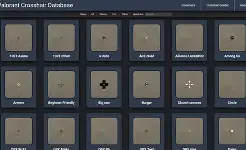Valorant’s detailed crosshair customization has always been essential for a player’s configuration. Over time, in 2025, the scene has only become more advanced: Pro players keep sharing new versions, while community databases and builders have made it possible to have better previews, and guides have sped up the process of importing and testing crosshair codes.
Why crosshair codes still matter
The crosshair is a minuscule but quite a powerful part of the ergonomic setup that affects target clarity, recoil visibility, and the way your eye tracks the movement. Quite a few high-level players are sharing the exact codes and thus, rookies are able to test the verified setups without any guessing.
Your crosshair codes make a mirror image of the pro’s reticle that is as detailed as it can be, so that you can figure out if a player’s aimbot is the result of the employed settings or just pure skill. Recently, there have been improvements in previewing and importing these codes, which have been mainly helped by the guides and databases.
What changed in 2025 — the practical updates
- Better pro crosshair databases and galleries: There are now more professional libraries that allow one to view several crosshair versions of a single pro athlete (some players while reticles) and also many of them provide previews on different backgrounds, hence more realistic testing.
- More up-to-date pro lists: Esports sites keep track of pro-player crosshair codes via lists that are continuously updated and also state which patch or event those codes were used in — this info is quite useful, when a player changes their settings during the season.
Crosshair builders along with live previews are unique features of the community that permit you to create codes visually and simultaneously adjust thickness, gap, dot, and movement/recoil options to test them before importing.
Where to find trustworthy crosshair codes
- Pro galleries and tracker sites: They list crosshairs used by top players and often provide several crosshair variants.
- Gaming outlets: Regular updated collections get most popular and meta crosshairs each season.
- Crosshair builders and community tools: For trying out and exporting your own crosshair if you want to make it from scratch.
How to import a Valorant crosshair code (step-by-step)
- Open Valorant and head to Settings → Crosshair.
- Press the drop-down icon next to Crosshair Profile and hit Import Profile.
- Put the code here that you copied from a website or builder and agree.
- Practice in Shooting Range and adjust color/opacity for your screen and map lighting.
Picking a crosshair that actually helps
- Simplicity is better than decoration: Small, high-contrast crosshairs or a small dot are most suitable for weapons like the Vandal or Phantom that require precision.
- Size and gap work as a trade: Narrower gaps give long-range precision; bigger gaps lower the number of elements for close-range combat.
Movement & firing options: A lot of players turn off movement/firing expansion to have a stable aiming point
Pro-player examples and why they’re popular
Pro crosshairs are known to be quite popular among players since they are very minimal and are designed to be visible across different lighting conditions. Some of the most popular players like TenZ, Hiko, and Boaster are always sharing their codes, and so, their subscribers have a ready common ground to start with. Starting with a professional crosshair as a baseline is a wise decision but you still need to adjust the gap and the size according to your tracking and flicking style.
Troubleshooting common issues
- Code won’t import: Check if the code string is complete and no spaces are added.
- Crosshair is invisible on maps: Try changing the color or the opacity and then test the crosshair in a completely dark and a completely bright corridor.
- It feels wrong in-game: Instead of immediately changing the gap or the size completely, just make short revisions in size or gap.
Quick testing routine (5–10 minutes)
- Put the new crosshair in your game.
- Do 2-3 minutes of practice on range bots with Vandal or Phantom at long range.
- Do 2–3 minutes of tracking drills and movement shots.
- Play 1–2 unrated matches for checking the performance of the crosshair under actual conditions.
Conclusion
- Maintain a small collection of 2–3 crosshairs: one for precise shooting, another for short-range, and a third one for a specific map lighting condition that is different from usual.
- Change them from time to time: Pros and the meta trend will change and plus the community tools make it faster to try out new codes.
- Participate in building of your own crosshairs with only slight modifications rather than pursuing those with flashy looks.
Also Read: Free Fire Max Hack Mod APK: Risks and Reality Explained
